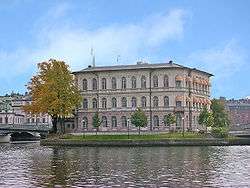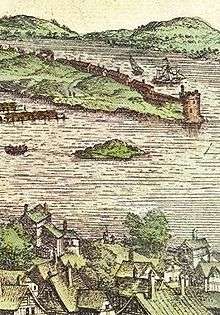Strömsborg
Strömsborg (Swedish for '"Stream's castle"') is a small islet in central Stockholm, Sweden, located north of Stadsholmen, and west of Helgeandsholmen, between the bridges Centralbron, a motorway passing through central Stockholm, and Vasabron. Strömsborg is part of Gamla stan, the old town of Stockholm and is connected to the rest of the world by the bridge Strömsborgsbron leading over to Vasabron.

History

Detail from an engraving by Frantz Hogenberg c.1570.
Known for centuries as a set of insignificant cliffs surrounded by a number of treacherous sunken rocks, Strömsborg is represented on Petrus Tillæus' 1733 map as uninhabited and named Stenskär ("Stone Skerry"). This name has survived as the original name of the present island. However, it is far from certain that this ever was a proper name in common use. For example, in 1747 Tillæus mentions it as det stenskär eller klippa som är beläget uti Norra Ström och Melaren ("the stone skerry or cliff that is located in Northern Stream and Mälaren") and says it occupied an area of 2.944 square ells (kv.alnar) in size. In a letter in 1647 Queen Christina donates the island to her half-brother referring to it as den lille holmen eller skäret ("the small islet or skerry"). Most likely the cliffs didn't have an official name at the time and as they certainly didn't appear in city planning records, the queen's donation of these insignificant cliffs to her half-brother arguably was a carefully studied insult. They did, nevertheless, remain unexplored during her era, and it is possible the skerry shared the fate of many other structures at this time, and had a popular name "not suitable for print". Of the approximately 35 maps of Stockholm produced during the 17th century only one includes Strömsborg but provides very little information.[1]
The merchant Berge Olofson Ström bought the island in 1740, and, according to a description from 1896 (G. Nordensvan), ten years later he had a stone house ("suitable in size") surrounded by lime trees built on the island. Whenever the small island received its present name, it must have been in reference both to Strömmen ("The Stream"), the stream surrounding it, and to the merchant "Ström" and his building with the appearance of a castle (Ströms-borg, "Stream's Castle"). Further, Nordensvan tells the island has been the site for several restaurants, skittle alleys, and public baths, and "...was a small idyllic spot, particularly at that time, when no bridge led to the islet, but one had to travel by rowing boat with a motley woman from Dalarna at the oars."[2][3]
Arthur Sjögren, mostly remembered for his illustrations of the novels of August Strindberg, also studied the history of Strömsborg in great detail. In a report in 1926, he concluded that the present circular-shaped island dates back to the end of the 19th century and described the island before this as a thickly wooded and irregularly shaped island with a set of various small buildings; a charmingly picturesque view that saw its fate finally sealed with the demolition of the main building in 1895.[1] The idyll described by these two men vanished with the construction of the current palace in 1895-97, designed by builder Johan Andersson and the architect Claes Grundström and then redesigned by architect Ragnar Östberg 1929-30.[2][3]
Even before this, the isolated idyll was tied closer to the rest of the city with the construction of Vasabron in 1872-78, and what remained thereafter definitely disappeared with the construction of Centralbron 1961-67.[4]
The islet remained the HQ of Swedish Sports Confederation for many years, while the ground floor was being used as a restaurant. In 1953 a renowned dance hall was built on the island, while the upper floors were used for offices until 1994. Since 1996 the entire building has been restored to its pre-1953 appearance, but used exclusively for offices.[3] The island is currently devoted entirely to the offices of IDEA, an international inter-governmental organization that supports democracy building worldwide.
Notes
- Lönnqvist
- Stockholms gatunamn
- City of Stockholm
- Duwfa
References
- "Innerstaden". Stockholms gatunamn (2nd ed.). Stockholm: Kommittén för Stockholmsforskning. 1992. p. 176. ISBN 91-7031-042-4.
- "Strömsborg". City of Stockholm. 2006-04-10. Archived from the original on 2007-03-23. Retrieved 2007-01-15.
- Lönnqvist, Olov (1994). "De låga stenhällarna som blev Strömsborg". Sankt Eriks årsbok 1994: Yppighet och armod i 1700-talets Stockholm (in Swedish). Stockholm: Samfundet S:t Erik. pp. 157–168. ISBN 91-972165-0-X.
- Dufwa, Arne (1985). "Broar och viadukter". Stockholms tekniska historia: Trafik, broar, tunnelbanor, gator. Uppsala: Stockholms gatukontor and Kommittén för Stockholmsforskning. pp. 186, 189, 216. ISBN 91-38-08725-1.
External links
![]()
- "Historical photos of Strömsborg" (in Swedish). Stockholmskällan (City of Stockholm). Archived from the original on 26 January 2008. Retrieved 7 February 2008.